The first quarter of 2018 for Mara Elephant Project has been one of the busier times that I can remember since we began in 2011. The rains began in January and did not stop through March creating a beautiful and green Mara ecosystem filled with many well-fed predators and growing elephant herds.
 Large elephant herds can be seen grazing in the Mara on the tall grasses fed by the rain.
Large elephant herds can be seen grazing in the Mara on the tall grasses fed by the rain.

The MEP intelligence unit continues to be extremely successful with 12 total suspects arrested and over 95 kg of ivory seized in the first quarter! We began 2018 with the arrest of two suspects with 50 kg of ivory and after interviewing the suspects it became apparent the tusks were from the Loita area on the Kenya/Tanzania border (pictured left). Additionally, in January, one suspect was arrested in the Oloolaimutia area by the Kenya Wildlife Service (KWS) and MEP rangers with 2 kg ivory. In February, we arrested three suspects with 18 kg of ivory in the Oldonyo Narasha area.
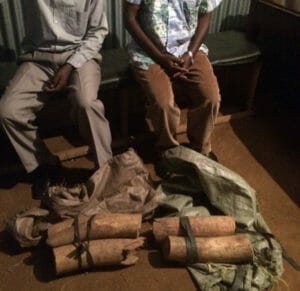 These suspects were intercepted by MEP intelligence and the operation was conducted by a joint MEP/KWS team. In March, another notable successful arrest and seizure by the intelligence unit when they arrested two middlemen with 17 kg of ivory on the Kenya/Tanzania border near the town of Isabania (pictured right). Additionally, in March, there were four suspects arrested in two separate operations with 8 kg of ivory by the MEP and KWS team. All of the above arrests were set up by the MEP intelligence team.
These suspects were intercepted by MEP intelligence and the operation was conducted by a joint MEP/KWS team. In March, another notable successful arrest and seizure by the intelligence unit when they arrested two middlemen with 17 kg of ivory on the Kenya/Tanzania border near the town of Isabania (pictured right). Additionally, in March, there were four suspects arrested in two separate operations with 8 kg of ivory by the MEP and KWS team. All of the above arrests were set up by the MEP intelligence team.
The growing trend that MEP has discovered in the first quarter of 2018 is that most of the ivory recovered is coming from areas in Kenya that are near the Tanzania border. This makes MEP’s efforts of securing areas like Loita, the Mau Forest and ensuring partnerships with Tanzania National Parks (TANAPA) and other Tanzanian authorities that much more vital to protecting elephants in the greater Mara ecosystem.
Speaking of the Mau Forest. In January, the David Sheldrick Wildlife Trust (DSWT) and MEP partnership started in the Mau Forest and the newly named DSWT Mau De-Snaring Team was established and immediately started having success in removing drop spears, snares and arresting poachers and shutting down illegal logging sites. This team was equipped with camping equipment, uniforms and sleeping bags and will undergo basic training in April at MEP HQ.
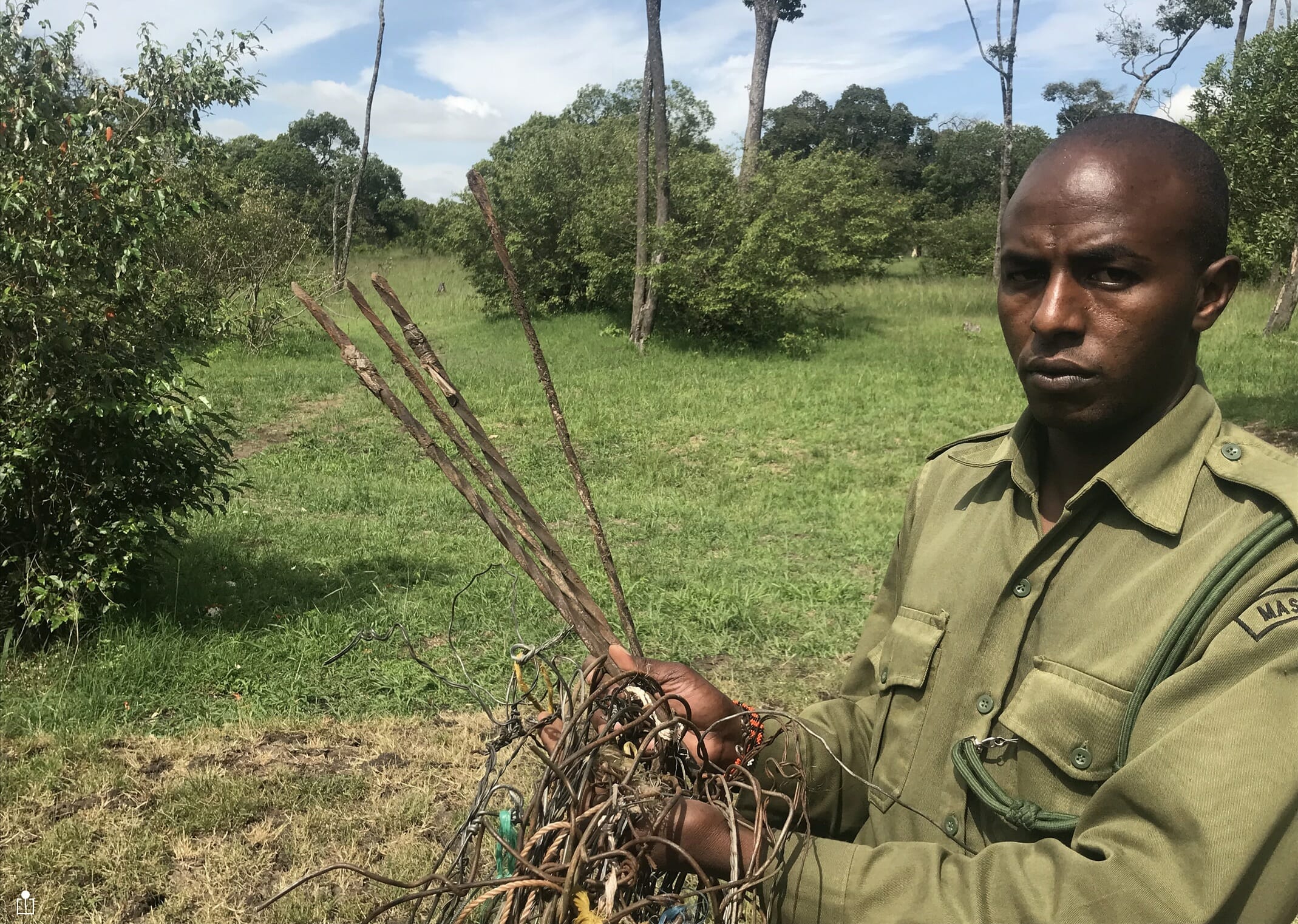 Drop spears and snares collected in the Mau Forest.
Drop spears and snares collected in the Mau Forest.
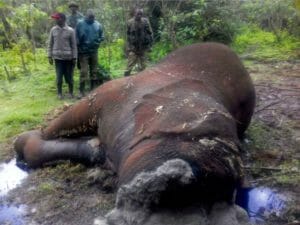
The ongoing elephant poaching in the Mau Forest is evident by the recent carcasses reported in March (pictured right) and we still don’t know the extent of the elephant poaching in the forest due the rough terrain and the very large area. One of the main reasons for the decline in poaching in the Mara has been close protection of elephants by following the individual herds in poaching areas. In the Mau this is more challenging, but we believe that the well-equipped highly mobile DWST team will be able to do this. Currently they are having great success in removing snares and more recently three poison-tipped drop spears that are used for killing elephants. Though we’ve as recently as March found a poached elephant carcass, the community has begun to work with MEP to retrieve intelligence about the ongoing poaching activities
Partnerships have been key to MEP’s success and in the first quarter of 2018, we’ve expanded existing partnerships and created new partnerships as a result of the high levels of poaching we’re seeing in areas of the Mara ecosystem. The Kenya Forestry Service (KFS) is a key partner to help MEP secure the Mau Forest. In March, I met with the KFS county director for security and the county police commander to start discussing the upcoming training of the Mau team and our ongoing concerns over the protection of elephants in the forest. We have requested additional rangers from the Narok County Government, KFS and KWS to be attached to the DSWT Mau Team so as to expand the area we are able to patrol.
The second area of concern is Mosiro, where in March, two dead elephants were found near Suswa. It is suspected that they ate watermelons laced with poison. This area has very little security and is outside of MEP’s area of operations, so we will need to investigate how we can have more of a presence in Mosiro in partnership with the South Rift Association of Land Owners (SORALO). SORALO has asked MEP to conduct human-elephant conflict training for their rangers in the southern rift. This is the area where we have our new collared elephant Julia, more on her later. MEP and SORALO are also keen to develop a partnership for better protection of the Loita Forest. All of this will ensure MEP is able to better protect elephants in this unsecured area of the ecosystem.
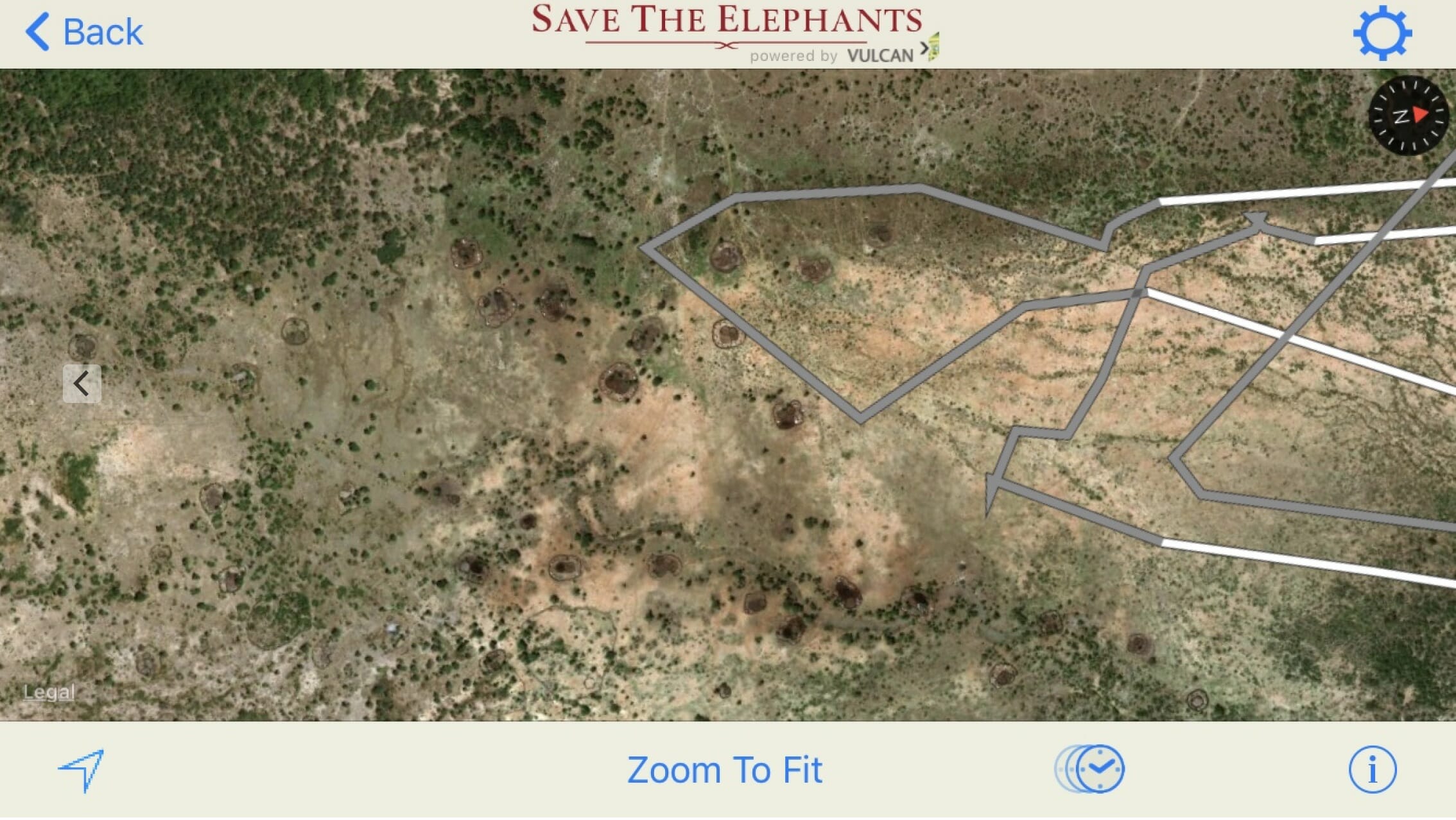
Julia’s tracks show her crop raiding at night.
In February, I was asked to go to Tanzania to offer my collaring expertise and the use of the Karen Blixen Camp Ree Park Safari helicopter to collar 12 elephants supported by the Singita Grumeti Fund. The operation was a huge success and already the elephant movement data is illustrating their conflict issues along an expansive border with communities. This operation also gave me a chance to meet my counterpart in Tanzania and learn a lot about how they manage conflict in their area of operation. In addition, we were able to link our head of intelligence with theirs that will form a formidable team operating on both sides of the border. Our intelligence team continues to work with the TANAPA and the Singita Grumeti Fund on several promising leads for recovering ivory and illegal firearms. The new partnership with the Singita Grumeti Fund is very promising because we’ll share collar data and intelligence data as part of the collaring operation in Tanzania. This will all lead to potentially mitigating conflict together contingent upon our flight permits in Tanzania being secured.
 Collaring an elephant in Tanzania.
Collaring an elephant in Tanzania.
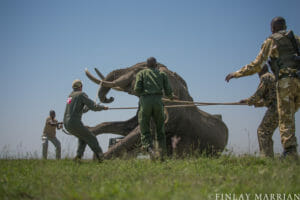 In collaring news for the first quarter of 2018, there was some good progress and some improvements to be made. In January, we re-collared Kegol, one of our large bull elephants, successfully. He’s an older bull so it was difficult for him to get up after being under, so this will be our last time collaring him (pictured right).
In collaring news for the first quarter of 2018, there was some good progress and some improvements to be made. In January, we re-collared Kegol, one of our large bull elephants, successfully. He’s an older bull so it was difficult for him to get up after being under, so this will be our last time collaring him (pictured right).
In March, we collared Julia, mentioned earlier. Julia is a breeding female that roams in a high human-elephant conflict area with her herd of 20 elephants and she has already given us important movement data to help us respond to crop raiding in the area. The bad news this quarter is that Nancy, our collared elephant in the Mau Forest, has had her collar drop off. Since she is the first forest dwelling elephant MEP has collared, we didn’t anticipate the wear and tear her collar would take in forest conditions. So, after five months of data collection that has helped with ranger deployment, it’s extremely frustrating to lose that. We will be re-collaring Nancy in April and have since found a solution for the elephant collar issue.
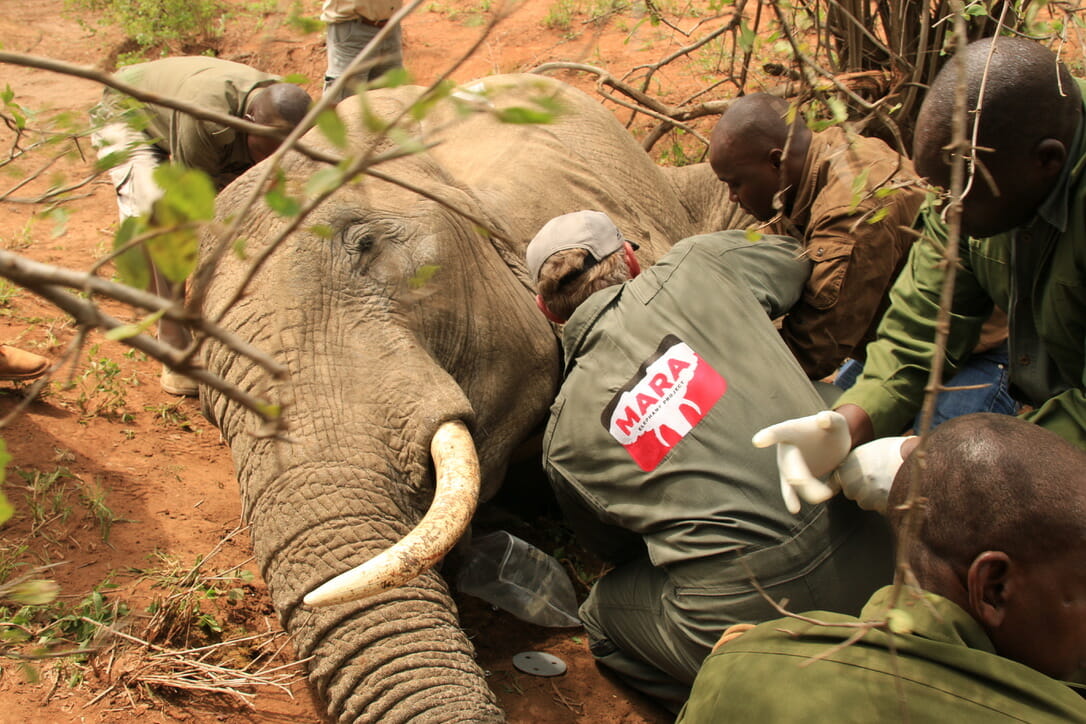 Julia’s collaring operation.
Julia’s collaring operation.
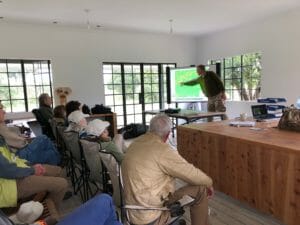 I am also pleased to report that MEP moved into its new office at HQ in March. The office was built for MEP by Tracks Trust to whom we are most grateful, not only for the new office but all the other facilities that they provide and maintain to support the operations of MEP. The new office provides space for myself, the tracking manager, our new administrator, Elvis, who joined us in January, a secure storage space, as well as offices for researchers and a large meeting room. We are still in the process of kitting out the offices, but it is wonderful to now have more space available from which to manage the growth of MEP, meet with partners, and accommodate visits from local tourism camps (pictured left) and donors to MEP (see the fundraising section for more about this).
I am also pleased to report that MEP moved into its new office at HQ in March. The office was built for MEP by Tracks Trust to whom we are most grateful, not only for the new office but all the other facilities that they provide and maintain to support the operations of MEP. The new office provides space for myself, the tracking manager, our new administrator, Elvis, who joined us in January, a secure storage space, as well as offices for researchers and a large meeting room. We are still in the process of kitting out the offices, but it is wonderful to now have more space available from which to manage the growth of MEP, meet with partners, and accommodate visits from local tourism camps (pictured left) and donors to MEP (see the fundraising section for more about this).
We are finalizing the 2017 MEP Annual Report right now. We need to wrap up our audited accounts and should be able to release that by May 1. Stay tuned for that email.
Finally, it’s important that we share with you that in January the forefather of conservation in the Maasai Mara passed away. Mr. William (Willie) Roberts came to the Mara in 1980 planning on farming wheat, but after seeing a gap in the protection of wildlife he soon became a full-time conservationist and naturalist. It wasn’t long before Willie was designated an Honorary Warden for the Maasai Mara and spent much of his time in anti-poaching operations including funding four rangers to collect snares in the area. He discovered that ivory poaching and illegal hunting were being promoted and protected by powerful individuals and at one stage he was threatened with deportation and even worse consequences after confiscating illegal ivory from a highly connected individual. Despite this, he continued his efforts, and was able to prevent the worst abuses in his area.

Willie Roberts in his uniform as Honorary Warden for Maasai Mara.
In the 1980s Willie’s close friendship with the Paramount Chief Ole Ntutu helped convince him to return his land to natural habitat, and to make his money from wildlife tourism rather than farming. Thus, the Mara Safari Club was established as the only substantial area in the Mara ecosystem where the conversion of wildlife areas to farming has been reversed as part of a deliberate decision.
In 1989, when Richard Leakey was appointed Director of the Kenya Wildlife Service, he asked Willie to join the organization as Commander of the Mara Platoon, which was put in place in order to provide security in the Maasai Mara National Reserve and its surroundings. During this time, threats to wildlife habitat in the Maasai grazing lands on the northern edges of the reserve were becoming acute, as Maasai landowners without lodges received no financial benefit from the vast numbers of tourists traversing their land. As a result, people were looking to convert their pasture into arable farmlands. Willie knew that to reverse this process it was imperative to provide financial benefits from tourism for all landowners.
In response, Willie singlehandedly brokered a deal with the Paramount Chief Ole Ntutu and Kenyan authorities to make the Ol Choro Oiroua Wildlife Management Association. The main objective of this organization – which was the first of its kind in Kenya – was to collect revenues from tourists using the members’ land and to manage the area for conservation. Without this example, it is likely that much of the Mara dispersal area that has been kept open for wildlife would have been transformed into arable farmland.
In early 2000, Willie was approached by the Transmara County Council to set up a private management team – as a non-profit company – to run the area known as the Mara Triangle, which is the western section of the Maasai Mara Game Reserve. The Mara Conservancy has been operating successfully since then and is the first example in Africa of a private enterprise being given the responsibility for management of a major state-owned park. During this time, there has been a spectacular improvement in conditions. With effective anti-poaching patrols, wildlife populations have recovered after years of decline, the road network is well-maintained and tourism numbers continue to grow. Revenue collection is efficient and transparent, with over US $1.5 million handed over to the county council and local communities every year. The Mara Triangle is a showcase of how conservation can work in Africa, and Willie Roberts can claim most of the responsibility for this success.
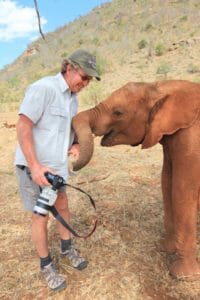
While an extremely successful conservationist, Willie was also an entrepreneur and saw the huge potential this magnificent area had for tourism, so, he founded Willie’s Camp. Willie’s son, Richard Roberts, MEP co-founder and trustee, continued his father’s legacy in the Mara with Richard’s Camp, a luxury camp that remains one of the most successful in the Mara. The whole MEP team gathered at HQ to observe a minute of silence in remembrance of Willie Roberts (pictured left). Go well Mzee and know we will be working hard to continue your legacy.


